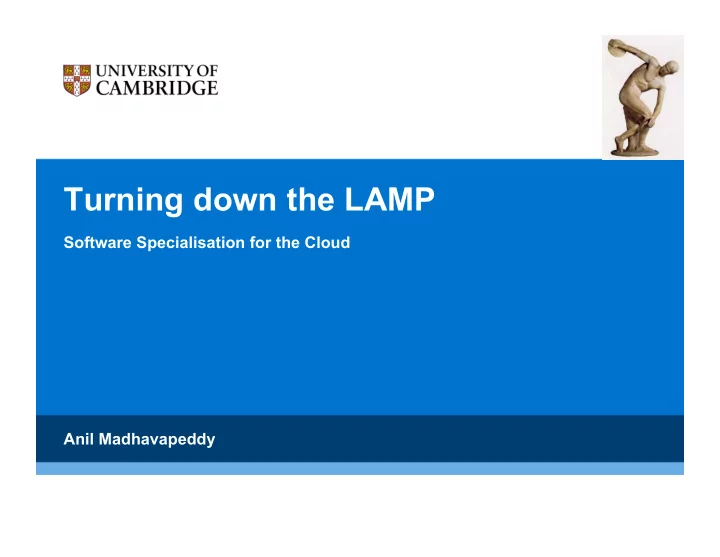

Turning down the LAMP Software Specialisation for the Cloud Anil Madhavapeddy
Motivation: Layers Application Threads Processes OS Kernel Hardware
Motivation: Layers Application Threads Language Runtime Processes OS Kernel Hardware
Motivation: Layers Application Threads Language Runtime Processes OS Kernel Hypervisor Hardware
Motivation: Security • Linux Kernel • Mar 1994: 176,250 LoC May 2010: 13,320,934 LoC Most core Internet services still written in C / C++
Approach: Reconstruct • Most layers are in place for compatibility • Xen: to run operating systems • Linux: to run POSIX applications • Processes: to protect C applications • If we start again, how much can things be improved?
Language • Choose a new implementation language that: • Has strong static typing • This improves performance (more work at compile time) • Reduces run-time bugs (memory safety) • Has a simple run-time system • Essential for a low-level systems language • Is extensible , e.g. for new methods of parallelization
Language: Objective Caml • Developed since 1996 in INRIA, France. • Based on the ML type-system: type inference , static typing • Proven in industry : • Citrix XenServer (virtualization) • Jane Street Capital (finance) • Skydeck, MLState (web) • Extensible type-system and grammar (FlowCaml, JoCaml, HashCaml)
DNS: Performance of BIND (C) vs Deens (ML)
DNS: with functional memoisation
MirageOS: Specialised application kernels
MirageOS: memory layout, concurrency Memory • 64-bit PV layout • Single process • Zero-copy I/O to Xen • 4MB super page mappings Concurrency Cooperative threading and events Fast inter-domain communication Works across cores and hosts
Mirage: storage Language-integrated storage: type t = { name: string; age: int } let me = { name = “Anil”; age=31 } let save () = t_save db me let get () = t_get ~age:(`Gt 30) db Advantage: SQLite is fast and simple Downside: interoperability. Object SCSI (Panassus) ?
Mirage: concurrency Language-integrated concurrency: let rec loop () = printf “hello!\n”; lwt s = sleep 2.5 in loop () # val loop : unit -> Lwt.t unit = <fun> Advantage: Blocking functions have a special type Lwt.t Downside: Extra function call overhead
MirageOS: SQL performance vs PV Linux
MirageOS: memory performance vs PV Linux
The Future: Multi-scale Operating System • We produce highly optimized kernels from a portable functional language code base which can adapt to the local hardware. • Same source code runs efficiently on: • mobile phone environment (e.g. using Cadmium or ARM) • desktop OS for development (e.g. using Eclipse IDE) • cloud for cheap scalability (using Xen kernel backend) • and soon GPGPU? FPGA? Intel SCC?
Applications • Dust Clouds • Thousands of tiny virtual machines (~100k each) • Same price as a few conventional “large” virtual machines • Sprinkle them world-wide to run Tor anonymity nodes • Self-scaling Services • As load spikes, request more resources dynamically from cloud • Detect resource imbalance and “migrate” globally on demand • All requires low-latency, high-reliability cloud APIs
Observations • Static address space layouts permit multiple language runtimes to run simultaneously in one VM container. • Alternative to Facebook compiling PHP to C++ using HipHop • Partial evaluation has the potential save huge amounts of energy • Already used in systems, e.g. libc/arch/x86_64 • Thinking multi-scale instead of multi-core is important for OS and language design: • Newer multi-core look like multiple hosts in many ways (failure, coherency, communication latency).
Questions? Open-source: http://github.com/avsm/melange http://github.com/avsm/mirage http://github.com/mirage Contact: avsm2@cl.cam.ac.uk avsm
Recommend
More recommend